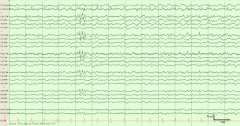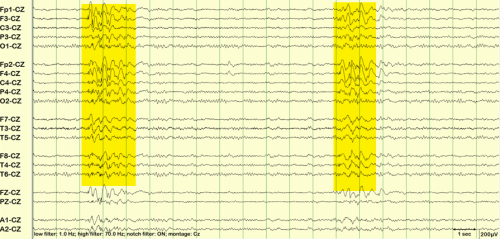Spikes and Sharp Waves
Spikes, sharp waves, spike & waves are common EEG wave forms.
Spike wave
-
A transient, clearly distinguished from background activity, with pointed peak at a conventional time scale and duration from 20 to less than 70 ms.
-
Amplitude varies but typically >50μV
-
Main component is generally negative relative to other areas
-
The term should be restricted to epileptiform discharges
-
EEG spikes should be differentiated from sharp waves, i.e. transients having similar characteristics but longer durations. However, it should be kept in mind that this distinction is largely arbitrary and primarily serves descriptive purposes.
-
EEG spikes should be clearly distinguished from the brief unit spikes recorded from single cells with microelectrode techniques.
Sharp wave
-
An epileptiform transient clearly distinguished from the background activity, although amplitude varies. A pointed peak at a conventional time scale and duration of 70-200 ms, usually with a steeper ascending phase when compared to the descending phase.
-
Main component is generally negative relative to other areas, and may be followed by slow wave of the same polarity.
-
The term should be restricted to epileptiform discharges, and does not apply to: (a) distinctive physiological events such as vertex sharp transients, lambda waves and positive occipital sharp transients of sleep, (b) sharp transients poorly distinguished from background activity (without or with a slow wave for example six Hz spike-and-slow-wave).
-
Sharp waves should be differentiated from spikes, i.e. transients having similar characteristics but shorter duration.
Spike-and-slow-wave complex
An epileptiform pattern consisting of a spike and an associated following slow wave, clearly distinguished from background activity.May be single or multiple
Epileptiform Temporal Spike and Waves
Six Hz spike-and-slow-wave
Synonym: phantom spike-and-wave (use of the term discouraged)
-
Spike-and-slow-wave complexes at 4-7 c/s, but mostly at 6 c/s occurring generally in brief bursts bilaterally and synchronously, symmetrically or asymmetrically, and either confined to or of larger amplitude over the posterior or anterior regions of the head.
-
Amplitude varies but is generally smaller than that of spike-and-slow-wave complexes repeating at slower rates.
-
when low amplitude, posterior and during drowsiness this pseudoepileptiform pattern should be distinguished from epileptiform discharges.
Smallsharp spikes (SSS)
-
A normal variant
-
Small sharp spikes of very short duration (<50 ms) and low amplitude (<50 µV), often followed by a small theta wave, occurring in the temporal regions during drowsiness and light sleep
-
also called “benign epileptiform transients of sleep” (use of term discouraged)
Polyspike-and-slow-wave complex
-
An epileptiform pattern consisting of two or more spikes associated with one or more slow waves
References
(1974) A glossary of terms most commonly used by clinical electroencephalographers. Electroencephalogr Clin Neurophysiol 37 (5):538-48. DOI: 10.1016/0013-4694(74)90099-6 PMID: 4138729.





